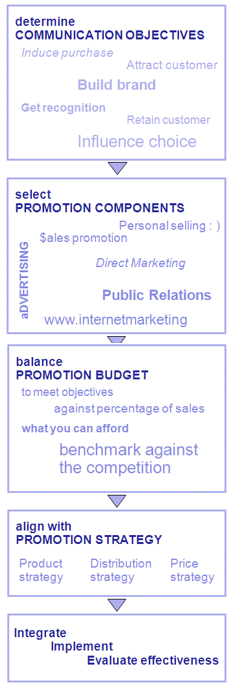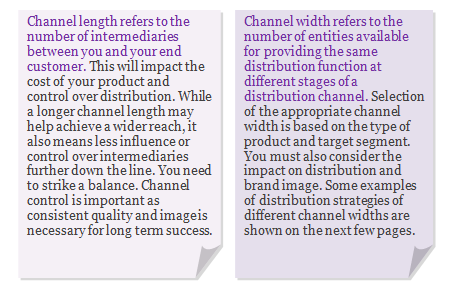Determine the Best Marketing Mix
Determine the best marketing mix. Choose a combination of tactical moves to put your product in front of the right customer at the right place, at the right price and at the right time.
A good marketing campaign is vital even when you have the best product. Most of us would have heard of some brilliant product that did not make it because not enough thought went into marketing it.
Going through a planning process before launching your marketing campaign will help you reduce costs and achieve better results for the same investment of time and money. Below are four components of your marketing mix that you need to think through:
Very often, companies focus only on the core aspects of their products when devising their product strategy.
They put in a lot of effort on the product and its functions and design but neglect equally important areas that make it easier or more desirable to buy their product. These areas include nicer packaging, longer warranty and clearer installation instructions. They can be used to differentiate from competitors. Make sure your product strategy covers all three components:
Core components include product, design and functions.
Be clear about what are you selling. What is the benefit that you are offering your customers? Is it relaxation, status, knowledge, efficiency or convenience? Look into product-line variations to satisfy different needs and to secure your customers.
Package your product to attract customers with its color, style, brand and quality. Find a good trade-off point between the attractiveness of your packaging and cost to maintain profitability.
Augment your product through a palette of support services such as warranty, delivery, maintenance and upgrading services.
Tip
Product Life Cycle
Each product goes through a product life cycle with each stage signaling a different level of response from the market. The length of each stage varies from one product to another.
- Introduction
- Growth
- Maturity
- Sales decline
You need to know:
Your product’s current life cycle stage. This is for you to adjust your marketing strategy accordingly.The length and rate of change of your product’s life cycle. You need to constantly innovate to extend your product life cycle or to introduce a successor.
Your customers. This is to anticipate any change in needs that could threaten your product, or spell new opportunities for expansion.
Your promotion strategy is the way you convey information to your target customers to positively influence what they think of your business and convince them to buy from you.
Everything you do or don’t do communicates something about your business. Therefore you need to plan your promotions carefully.
Below are some suggestions that you can try out to achieve your company’s aims of communicating with customers, attracting and retaining them and increasing sales.
To attract or retain customers
- Give out free samples or premiums (free gifts or prizes)
- Create novelty
- Issue discount coupons or rebates
- Start a loyalty or rewards programme
- Offer bundle or volume pricing
To communicate your brand and nature of business
- Distribute brochures or leaflets
- Send direct mails
- Use point-of-purchase displays
- Conduct seminars or give talks
To increase sales
- Have an effective sales management process
- Train your sales people
- Develop sales promotion tools
- Co-operate with partners
- Participate in trade shows
Channel strategy is probably the most complex among the marketing mix strategies. It requires clear analysis on what your business model is about.
There is no one correct model for all markets. Each market is unique and you need to understand both the market and the situation to adopt the most appropriate distribution method for that market.
To understand the market, you need to consider these factors:
- Is your product targeted at consumers or businesses?
- Do you sell through partners or do you deal directly with consumers?
- Is the market large? What is the expected reach?
- Are there issues and complexity in distribution? These can be a result of terrain, competition or other factors.
- How much control over the channel do you require?
- Are there any key players in the market? Who are they and what products do they carry? Will they work with you or against you?
- Do you have bargaining power? If so, what is it based on?
Tip
Impact of the Internet
The Internet has the potential to dramatically change the balance of power among consumers, retailers, distributors, manufacturers and service providers in the international marketplace.
While the Internet is necessary for companies to engage their customers, it is important for companies to consider e-commerce carefully. Some companies adopt a “no e-commerce” policy with only a website presence on the Internet.
Case Study
Exclusive partners
Wisconsin Ginseng & Herb Co-op appointed Eu Yan Sang as its exclusive worldwide distributor for the Wisconsin-grown American Ginseng, one of the world's finest forms of ginseng.
By granting an exclusive distributorship, Wisconsin gains access to Eu Yan Sang’s regional network of retail outlets and traditional medical clinics where the products may be prescribed and consumed. Wisconsin also secured the commitment of Eu Yan Sang to ensure the success of the product, as they now have a business interest in it.
Case Study
Changing with the times
Dell Computer started with a business model of going direct to its customers. Customers could call their hotline and place orders for their computers. The products will then be delivered directly to their customers, bypassing the need for a middleman.
As time went on, customer needs evolved and the direct model no longer worked well for Dell. Customers buying notebooks now prefer to “touch and feel” the product before purchasing. To address this, Dell decided to expand their distribution network by adopting the selective distribution approach. They carefully selected suitable resellers where the Dell computers can be displayed so that customers can have “hands on” experience with their products.
Sales licence in a specified market is given to an unlimited number of dealers.
This model is used when:
- The intention is to create accessibility and allow consumers to buy your products anywhere and everywhere.
- It is necessary to have a wide coverage of the market.
- Dealers often compete with each other on price.
Case Study
A can of cola
Intensive distribution is required since no customers will travel to an exclusive distributor to buy a can of cola. The more easily available the product the higher chance of sale, since customers have easy access to the product. The distribution channels may range from vending machines to 5-star hotels.
Price
Pricing decisions are made amidst a changing market landscape. You need to take into consideration the market environment, competitors’ products, your company’s range of products, changing consumer tastes, disposable incomes, and a host of other external and internal factors.
Pricing decisions are central to your decisions on marketing strategy and choice of marketing mix.
[You may base your marketing mix on price.]
Your market research may have identified a market segment for inexpensive instant coffee. You might then set a target selling price and then select ingredients and roasting processes which will keep the product price within this target. In this case, price is the starting point that determines product positioning, product formulation, packaging, promotional strategy and distribution.
[You may base your price on your marketing mix.]
You may decide that in order to achieve sufficient market penetration, the product must be promoted through mass media. The price of the product would have to be set to cover the cost of this relatively expensive channel of communication. If your marketing plans include building a new product image, gaining access to a special channel of distribution or using an innovative form of packaging, the price would also have to be adjusted to cover any additional costs.
A good starting point from which to decide on an optimal price is to first determine the objectives you want to achieve.
This will then give direction to your pricing decisions.
- Do you want to achieve maximum market penetration? You will need to set the lowest price possible to capture market share.
- Do you want to achieve maximum profit? You will need to set the highest price possible, while taking into consideration demand. This may also communicate the image of a superior product.
- Do you just want to survive in the market? You can look at short-term solutions where the price simply covers variable cost and some fixed costs.
When your competitors start cutting prices to increase market share, you may have to consider the following strategies.
- You can choose to maintain price if you think you will lose too much profit once price is reduced. You should anticipate that you will not lose too much market share and that you can easily regain lost share when necessary. For example, competitors’ price cut is seen to be a temporary measure.
- You can choose to maintain price and add value if you are able to improve your product, design, functions, packaging or support services.
- You can choose to reduce price if the market is price sensitive and maintaining price will result in loss in market share. This is essential as it is hard to rebuild market share once it is lost. You should be able to reduce production costs with increased volume or at least, be able to manage a reduction in profits in the short run.
- You can choose to increase price and improve quality or introduce new products to take on your competitors.
- You can choose to launch a low-price fighter line or even create a separate, lower-priced brand.






